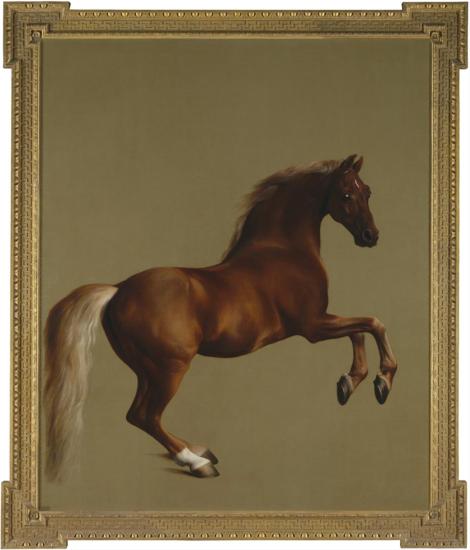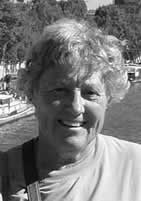
George Stubbs, Whistlejacket, 1762, National Gallery, Londen
In the Mauritshuis, open again from 1 June, a parade of prize-winning horses passes by until 30 August, painted by the 18th-century George Stubbs. Still relatively unknown in the Netherlands, but a phenomenon in Great Britain. Stubbs met the need of horse owners to show off their noble four-legged friends and have them captured on canvas. As a child, he was already fascinated by the anatomy of humans and animals and a master of depicting a horse. He painted skin, hair, muscles, veins and movement with great precision. Stubbs managed to depict the physical characteristics of a horse so well that his portraits were really recognizable to the owners of the horses.
The eye-catcher at the exhibition is the painting of Whistlejacket, a racehorse from the stable of British politician Charles Watson Wentworth and direct descendant of the three progenitors of the English thoroughbred breed. The work is so special because of its size (almost three meters high and two and a half meters wide) and the fact that nothing but a prancing horse is depicted. Stubbs gives the beauty of the animal all the attention. It becomes clear when looking at his paintings that the painter liked horses more than people. If people are already portrayed, they are always a bit wooden.
In our own country, a century later, painters also worked for clients who wanted to see their beloved pets immortalized. Anthony Oberman, for example, painted the hard trotters De Vlugge and De Rot by the Amsterdam banker Adriaan van der Hoop in the English tradition around 1828. Most animal painters specialized in a specific animal species. For example, the 19th-century Wouterus Verschuur – already a famous painter at the time – excelled in depicting horses. From his teacher, the cattle painter Pieter Gerardus van Os, Verschuur learned to record their construction and movements to perfection and, like Stubbs, was interested in their character. The horses that he and colleagues painted as his son Wouter Verschuur jr. And Willem Karel Nakken were portrayed in pastoral, idealized circumstances. We see landscapes in which they stand quietly by a fence, are prepared for the ride with their wealthy owner, or we look at how they are traded on the horse market. In the paintings depicted here we see a colorful procession passing by. A day out in Hyde Park, on the racecourse – in the Netherlands a public horse racing culture arose around 1885 – on the horse market, as an elegant riding horse, a standing horse, an Indian horse, a friendly horse, a fed horse, a mare with foal or just a horse with man.
In the 19th century the animals were rendered more or less idealized, with Impressionism the animals are actually seen. The depiction of the animal becomes more natural, less posed, as if the painter has put what he saw outside or inside on the canvas. Both The Hague and Amsterdam Schools had a predilection for the workhorse: the sleigh horse or the riding artillery on the beach, the agricultural horse in the countryside or the draft and carriage horse in the city. It is a final tribute to an animal that would disappear from everyday life in the 20th century through mechanization.

Pleun Honig, former pharmaceutical vet
Workhorses were a very popular subject. They were depicted with large heads, muscular bodies, a lot of ‘wallpaper’ on the legs, busy at work. In addition, there are images of somewhat lighter built harness horses. Then you have racing horses for under the saddle and trotters for the sulky. The trotter is the lightest type of horse, about 450 kg. A Zeeland tuber weighs almost twice as much. Horses are more aware of the different types, both in painting and in reality. Everyone knows that a so-called farm tuber looks different from a sport horse.
Horses used to play an important role in warfare. Tens of thousands of riding and draft horses died in various wars (Napoleon campaign, WWI, WWII). Or they were simply left behind when the odds turned. For example, British horses were left in Egypt after the First World War for economic reasons (transport costs) and as development aid.
There are quite a few images of ice scenes where a horse walks across the ice in front of a horse-drawn sleigh. This is only possible if there are some spikes screwed at the bottom of their horseshoes. This is called “sharpening”. It does increase the risk of self-injury, especially if the horses want to lie down. But horses don’t often lie. Their lungs, which have few connective tissue stiffeners, cannot cope with this. Their body pressure is too great for their lungs and like a whale on dry land they would suffocate under their own weight. Foals are still so light that they can lie for a long time.
How do horses rest? You often see relaxed horses take turns relieving their back legs in turn, fixing one leg and locking the knee. Back legs can be lifted more easily than front legs due to the weight of the neck and head. A horse or cow kicks at you with its hind legs. A dog limps smoothly with a hind leg in the air, but stumbles with a painful foreleg. It is therefore very unnatural if horses are painted prancing horizontally. There is a clear difference in temperament between horse breeds. The cold bleeds are calm and reliable, they must remain still when the plow is turned or the harvesting wagon is loaded. A more temperamental animal does not like to stand still. The more warm-blooded or ‘nobler’ the breed, the more nervous they often behave. Not always easy to deal with.
Horses are much more susceptible to diseases than cows. They are more likely to fail and they take it more seriously. For example, there is the Monday illness (standing still after a weekend without adjusting the diet to that rest, going back to work on Monday and then having a violent muscle reaction). Or stable legs (standing too long and then accumulating fluid in the legs). Colic (intestinal cramps) is a dreaded condition. They can die easily. The end of many horses is the same as for the cows: the butcher. Except for horses that were very attached to and in countries where people do not want to eat horse meat in principle, and even there it is sometimes consumed unnoticed by meat fraud.